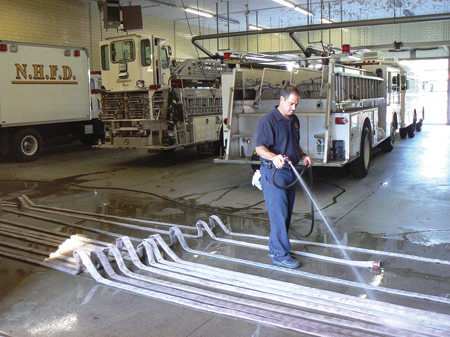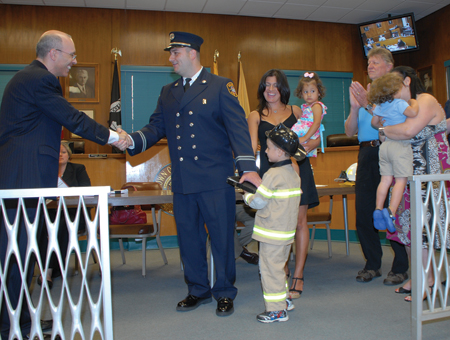BY JIM SILVERNAIL AND FRANK VISCUSO
Theirs not to make reply, Theirs not to reason why, Theirs but to do and die: Into the valley of Death Rode the six hundred.
“Our future is very questionable because this generation cannot follow and obey directives.”
This is an assumption many seasoned veterans and leaders of the American fire service often make about the new generation entering our ranks. This new breed of warrior has been programmed to ask, “Why?”
Forward, the Light Brigade!’ Was there a man dismay’d? Not tho'(though) the soldiers knew Someone had blunder’d: Theirs not to make reply, Theirs not to reason why, Theirs but to do and die: Into the valley of Death Rode the six hundred.
 |
| (1) New firefighters must be taught the importance of keeping their station clean and organized and their equipment in good working condition. (Photo by Frank Ricci.) |
The Charge of the Light Brigade, cited above, described gallantry and selflessness by a generation of men who placed directives before their well-being. This poem by Alfred, Lord Tennyson, immortalizes the British light cavalry led by Lord Cardigan against Russian forces during the Battle of Balaclava during the Crimean War in 1854. As the poem explains, this force faced superior numbers against tremendous odds. However, the brigade did not refuse the order and, without question, carried on with their disastrous task.
The men and women entering the fire service today are mostly found within the category of Generation Y, or the Millennial Generation, born after 1982. Some new entries can even be considered late Generation Xers. Regardless, both are considered the “me” generations, typically categorized by narcissism and entitlement. These two qualities are not typically productive within the confines of a fire station or the fireround. However, before we write off our future, we need to take a deeper look into motivation. Also keep in mind that these individuals possess another quality that should not be overlooked and that has been overwhelmingly revealed by the Iraq and Afghanistan war campaigns. That is their strong sense of civic duty.
When faced with superior challenges, will our youngest generation of firefighters stand up to the task? Will they face the odds and place their lives on the line? Doubts aside, the answer is overwhelmingly yes. In this generation of asking “why” before answering directives, how can this be? The underlying answer is motivation.
Motivation
People who answer the calling to enter into the fire service know the danger and peril they will face on a daily basis. As leaders, we might ask, “Why?” They see the images of the Super Sofa Fire in Charleston, South Carolina, where nine firefighters gave their lives. They saw the explosion in Texas that killed 10 members of the West Volunteer Fire Department in April 2013 and four firefighters die a month later in Houston at the Southwest Inn Motel fire. Even the main characters in Backdraft and Ladder 49 perish in the end.
 |
| (2) Sincerely caring about the career ambitions of your team members will earn you their respect and help keep them motivated. (Photo by Diane Tilley.) |
New recruits begin their adventure into the fire academy with the same sense of adventure as that of explorers, conquistadors, and merchant marines. Most reason that it is a humanitarian effort, an opportunity to help their fellow man. This is a noble answer; however, it is generic and not always accurate. Most of us are looking for the “rush” and the adrenaline of being the ultimate warrior, emerging from the smoke with the baby in our arms. It is modern day gallantry.
Unfortunately, reality sets in. A few months or years after graduating, the neophytes realize that fires don’t happen every day. There is less glamorous work involved in this profession, such as public relations, maintenance, and even house cleaning (photo 1). Eventually, our newbie gains his first sense of courage, and the question evolves, “Why?”
Harnessing the Motivation
It is our duty, as leaders, to keep our people engaged no matter what task is at hand. It is easy to motivate an individual to go to the fire. It is more difficult to impress him with the importance of public relations and other aspects of the job.
Performance management objectives are the ultimate measurement of desired job behaviors and task completions against the mission of the organization. The central focus of any manager/leader is to get the employee to perform to a level that supports the achievement of the mission statement. This is easier said than done, since we do not make widgets. Our objectives cannot be measured by the bottom line and a profit margin.
The link in the system is motivation. Motivation is how we lead our people toward achieving organizational goals and, ultimately, the mission of the organization. Managers mandate directives and tell subordinates how to perform. Leaders understand motivation and help employees to want to achieve and make the organization better.
Therefore, it is important to understand why people decide to become firefighters and to harness this energy throughout the duration of their careers. We need to understand the need for belonging and the excitement behind our profession and somehow connect this to menial, yet important, tasks. Legendary basketball coach John Wooden believed one of his main objectives as a coach was to find his players’ “why.” Wooden realized that the “how” didn’t mean much at all if the players lacked motivation. A skilled fire service leader should also recognize this fact.
It’s easy to become lazy and complacent in a job that has as much “downtime” as we have in this industry. It’s also extremely dangerous. So the question becomes, “What should a leader in today’s fire service do with that so-called “downtime?”
Should we find creative ways to train? Of course. Should we consistently focus on educating our team? Of course. Should we spend time motivating those around us? The answer is, yes, of course. The problem is that many people in leadership positions don’t know how to do this. There are simple ways to motivate people on your team. Treating people fairly and kindly should be no-brainers (but, unfortunately, they are not). Getting people involved is a great motivator because it helps connect them to the mission of your organization. Keeping them in the know is also important in today’s day and age. Our industry is changing, and people want to know they have security and the support of their leadership. We can discuss various motivational techniques, but the fact is that circumstances, the people involved, and the prize at stake will help you determine the best methods to use.
In 1519, a Spanish conquistador named Hernando Cortez assembled an army of 500 and set out to take the world’s richest treasure that had been held by the Aztec Empire for six hundred years. Army after army had tried to take this treasure, but they all failed because the natives outnumbered and outfought all the other armies. Cortez knew what he was up against and could sense the doubt creeping into the minds of the men as they sailed toward their destination on several ships. One of the things Cortez did to keep their mind focused on the prize was speak to his soldiers about how their life was going to improve after they acquired the treasure, how their families would never have to struggle again because of the treasures they were going to take.
This talk only worked for a short time because their food supply was running low. He knew that when they landed on Veracruz, they would be tired and hungry. He knew the natural instinct of his army, which was probably the same as that of any other group facing such overwhelming odds.
He also knew that once they landed and stood opposite the Aztecs, they would realize, for the first time, they were severely outnumbered and outmatched. Cortez believed his army would try to retreat to the boats. He needed to make their level of commitment beyond that of the others who tried before him.
When he reached his destination, Cortez gathered his army before the battle. I’m sure they expected a strategic talk, maybe a motivational speech, but he knew that that would not be enough. Instead, he turned to men with torches and said three words, “Burn the boats.” He continued, “If we’re going back home to our families, we’re going home on their boats.” Cortez and his army defeated and conquered the Aztec Empire, and they took the treasure.
The term “Burn the boats” has since been connected to individuals and teams that have made the decision to not look back. Although that may be extreme in most cases, what Cortez did on the boat was not. He spent time getting to know what his team members valued and helped cultivate a vision of how their lives could improve if they focused on the task at hand.
We may not be storming beaches and taking treasures, but our job is just as dangerous. A person’s level of motivation shouldn’t be in question when he takes an oath to become a firefighter. This is arguably the most dangerous job in the world. In today’s society, however, a person’s level of motivation-in general-is always in question.
Career Advancement
When was the last time you spoke with the men and women under your charge about their career ambitions (photo 2)? Cortez didn’t “just know” his crew. His actions weren’t based on applications or assessment tests. Leaders in the fire service must spend time speaking to their crews. Stopping to answer the question “why” might discourage managers, but it might benefit them to ask the same question.
Don’t just answer their questions of why we think the job is important but also ask them “Why?” Instead of telling the next generation why they should follow in our boots, ask them why they want to? If you want to know why this generation will take the time to continue improving our industry, ask them “Why?” Get to the bottom of why they are in the industry and what’s important to them. Great leaders will find a connection between a crew’s priorities and the organizational goal.
When can their glory fade? O the wild charge they made! All the world wonder’d. Honour the charge they made! Honour the Light Brigade, Noble six hundred!
JIM SILVERNAIL is a battalion chief with the Metro West (MO) Fire Protection District. He is the author of Suburban Fire Tactics (Fire Engineering, 2013). He has more than 18 years of operational experience and is a lead instructor at the St. Louis County Fire Academy, specializing in truck company operations. He is also a member of MO-TF1, a board member of the ISFSI, and a principal member of NFPA technical committee 1710. He has written articles for Fire Engineering and is a workshop instructor at FDIC International.
FRANK VISCUSO is a career deputy chief from Kearny, New Jersey. He is a contributor to Fire Engineering magazine and the author of six books including Step Up and Lead, and Step Up Your Teamwork. He is a certified fire instructor and keynote speaker. Over the past decade, he has spoken to audiences in and outside the fire service on leadership, team building, and officer development.
Their Rookie Year is Our Responsibility
Mentoring: Perspectives of the Rookie and the Veteran
Firefighter Training Drills: Are You Smarter Than a Rookie ?

